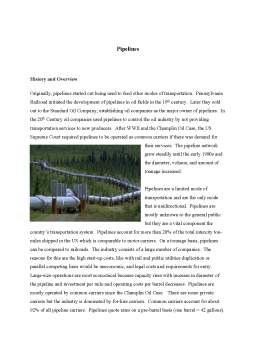Extras din referat
History and Overview
Originally, pipelines started out being used to feed other modes of transportation. Pennsylvania Railroad initiated the development of pipelines in oil fields in the 19th century. Later they sold out to the Standard Oil Company, establishing oil companies as the major owner of pipelines. In the 20th Century oil companies used pipelines to control the oil industry by not providing transportation services to new producers. After WWII and the Champlin Oil Case, the US Supreme Court required pipelines to be operated as common carriers if there was demand for their services. The pipeline network grew steadily until the early 1980s and the diameter, volume, and amount of tonnage increased.
Pipelines are a limited mode of transportation and are the only mode that is unidirectional. Pipelines are mostly unknown to the general public but they are a vital component the country’s transportation system. Pipelines account for more than 20% of the total intercity ton-miles shipped in the US which is comparable to motor carriers. On a tonnage basis, pipelines can be compared to railroads. The industry consists of a large number of companies. The reasons for this are the high start-up costs, like with rail and public utilities duplication or parallel competing lines would be uneconomic, and legal costs and requirements for entry. Large-size operations are most economical because capacity rises with increase in diameter of the pipeline and investment per mile and operating costs per barrel decreases. Pipelines are mostly operated by common carriers since the Champlin Oil Case. There are some private carriers but the industry is dominated by for-hire carriers. Common carriers account for about 92% of all pipeline carriers. Pipelines quote rates on a pre-barrel basis (one barrel = 42 gallons). Quotes are typically point to point or zone to zone and a minimum shipment size is usually required.
Ownership
Oil companies have been predominate owners of oil pipelines since Standard Oil Company bought out the Pennsylvania Railroad. The Federal government briefly owned during WWII to ensure uninterrupted flow of oil during the war. The government owned the Big Inch and the Little Inch pipeline but sold to private companies after the war. Some pipelines are operated as joint ventures because of the high capital investment need for large-diameter pipelines. Oil companies own about 46%, joint ventures account for 27%, and railroads, independent oil companies, and other companies account for the remaining percentage.
Competition
The industry has limited intramodal mostly due to the small number of companies and the market structure of having limited price competition, joint ownership, and high capital costs. The most serious intermodal competition is water, or tanker, operations. Water come the closest to matching pipeline’s costs and rates but water’s limited network limits their ability to compete. Trucks complement rather than compete because trucks distribute/deliver for pipelines. Once pipelines have been constructed between 2 points it’s difficult for other modes to compete because of the low operating costs, dependability, and limited damage to product being transported.
Bibliografie
Coyle, John Joseph, Edward J. Bardi, and Robert A. Novack."Pipelines."Transportation. 4th ed. St. Paul/Minneapolis: West Pub., 1994. 241-255. Print.
"Freight Modes in Kentucky." Kentucky Transportation Cabinet, Apr. 2011. Web. 26 Apr. 2012. <http://transportation.ky.gov/Planning/Documents/Freight%20Modes%20in%20Kentucky.pdf>.
Fricker, Jon D., and Robert K. Whitford."Oil and Gas Pipelines."Fundamentals of Transportation Engineering: A Multimodal Approach. Upper Saddle River, NJ: Pearson Prentice Hall, 2004. 672-74. Print.
"Kentucky Transportation Cabinet - KYTC." Web. 26 Apr. 2012. <http://transportation.ky.gov/Pages/default.aspx>.
"Keystonepipelinexl."Keystonepipelinexl.U.S. Department of State, n.d. Web. 19 June 2012. <http://www.keystonepipeline-xl.state.gov/>.
"Keystone XL Pipeline Project."Keystone XL Pipeline Project. TransCanada, 9 May 2012. Web. 19 June 2012. <http://www.transcanada.com/keystone.html>.
"TransCanada's Keystone XL Pipeline Know the Facts." TransCanada, June 2021. Web. 19 June 2012. <http://www.transcanada.com/docs/Key_Projects/know_the_facts_kxl.pdf>.
Preview document
Conținut arhivă zip
- Pipelines Transport.doc
















